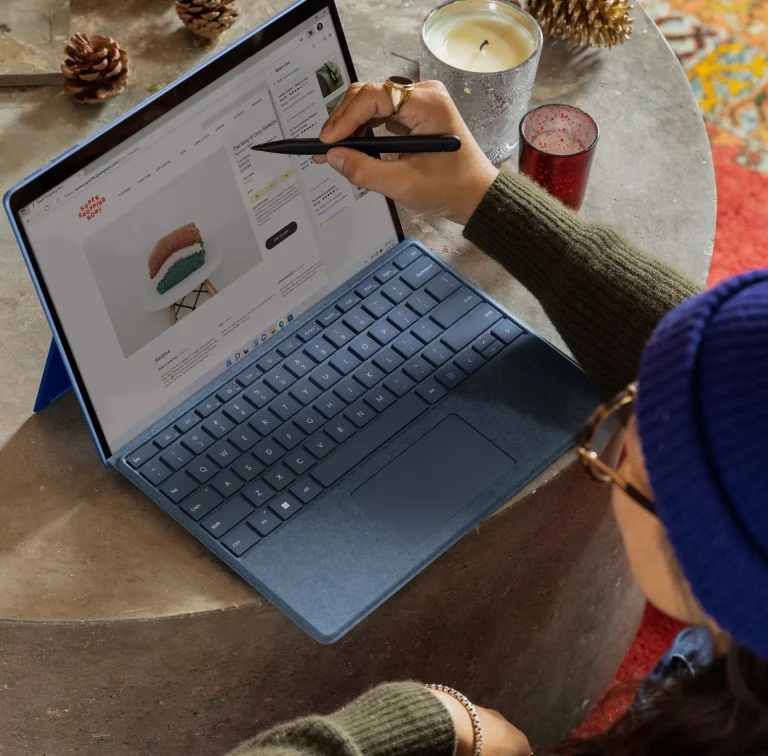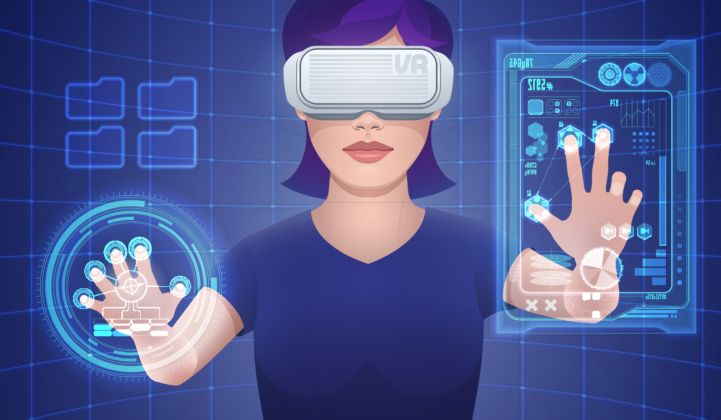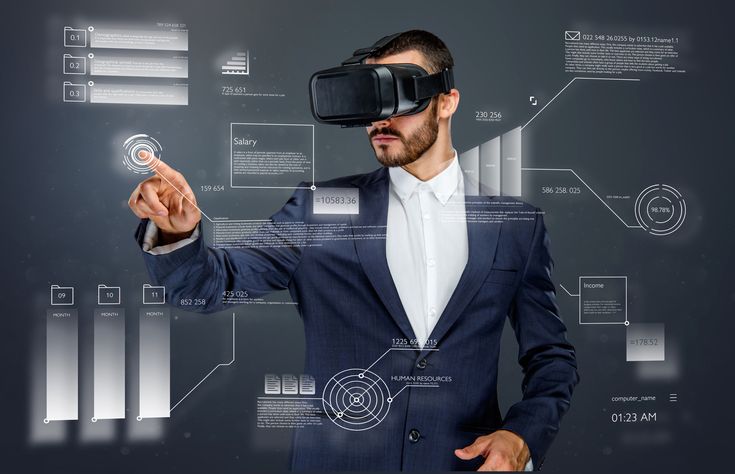The Future of Business: Exploring B2B Augmented Reality & Virtual Reality Services
Virtual and Augmented Reality are no longer confined to science fiction or entertainment applications. Today, these cutting-edge technologies are transforming the B2B landscape, offering innovative solutions that blend digital content with the real world. From enhancing users’ ability to interact with virtual objects to revolutionizing industries like medical training and e-commerce, AR and VR are redefining how businesses operate. In this blog, we’ll explore B2B AR and VR services, exploring their applications, benefits, and the future they promise.



What Are Augmented Reality and Virtual Reality?
Understanding Augmented Reality (AR)
Augmented reality (AR) refers to technology that overlays digital information in the real-world environment. Using devices like smart glasses, AR headsets, or even a phone’s camera, AR enhances the user’s environment by blending digital content with elements of the physical world. For example, Google Glass and other AR systems enable users to see virtual objects superimposed on real-world coordinates, seamlessly integrating the virtual and physical worlds.
Understanding Virtual Reality (VR)
Virtual reality (VR), on the other hand, immerses users in a completely simulated environment. Through VR headsets like the Meta Quest, users are transported into a virtual world where they can interact with virtual objects and environments. Unlike AR, which enhances the real world, VR replaces it entirely, offering an immersive experience that can be used for everything from virtual meetings to surgical simulations.
The Key Difference Between AR and VR
The key difference between AR and VR is their interaction with the real world. While AR enhances the real environment by adding virtual information, VR creates a fully virtual environment detached from the physical world. Both technologies, however, rely on advanced hardware components, data processing, and artificial intelligence to deliver their functionalities.
The Evolution of AR and VR
A Brief History of AR and VR
The term augmented reality (AR) was first coined in the 1990s, but its roots trace back to the 1960s with the development of head-mounted displays (HMDs). Virtual reality (VR) also emerged around the same time, primarily for entertainment applications like video games. Over the decades, advancements in processing power, gesture recognition systems, and input devices have propelled AR and VR into the B2B and consumer markets.
AR and VR Today
Today, AR and VR are more accessible than ever. AR applications range from e-commerce platforms that enable users to visualize products in their natural environment to medical devices that improve patient safety. Meanwhile, VR solutions are used for virtual demonstrations, training simulations, and even virtual tours of entire buildings. The VR market is booming, with VR platforms becoming increasingly sophisticated and user-friendly.

How AR and VR Are Transforming B2B Services
Enhancing User’s Ability with AR and VR
One of the most significant advantages of AR and VR is their ability to enhance the user’s ability to interact with digital content. For instance, AR systems can provide heads-up displays that overlay critical information onto the user’s environment, improving decision-making and efficiency. Similarly, VR platforms can simulate real-world scenarios, enabling users to practice skills in a safe, controlled virtual environment.
Revolutionizing Medical Training
In the healthcare sector, AR and VR are revolutionizing medical training. Surgeons can now use AR headsets to visualize patient anatomy in real time during procedures, while VR platforms offer surgical simulation for training purposes. These technologies improve patient safety and reduce the risks associated with traditional training methods.
Streamlining E-Commerce and Retail
AR is making waves in the e-commerce industry by enabling users to visualize products in their real-world environment before purchasing. For example, furniture retailers can use AR applications to show how a piece of furniture would look in a customer’s home. This blend of digital and physical worlds enhances the shopping experience and reduces return rates.
Improving Virtual Meetings and Collaboration
With the rise of remote work, virtual meetings have become a staple of modern business. VR takes this a step further by creating immersive meeting spaces where participants can interact as if they were in the same room. This level of engagement is unmatched by traditional video conferencing tools.
Key Technologies Powering AR and VR
Input Devices and Gesture Recognition Systems
Input devices like controllers and gesture recognition systems play a crucial role in AR and VR experiences. These tools enable users to interact with virtual objects and navigate virtual environments seamlessly. For example, gesture recognition systems can track the user’s hand movements, allowing for intuitive control of virtual content.
Artificial Intelligence and Data Processing
Artificial intelligence (AI) and data processing are the backbone of AR and VR technologies. AI algorithms analyze scene geometry and user’s head movements to ensure a smooth and immersive experience. Meanwhile, powerful data processing capabilities enable real-time rendering of complex virtual environments.
Hardware Components
The success of AR and VR relies heavily on advanced hardware components. AR devices like smart glasses and AR headsets use solid-state compasses and digital compasses to track the user’s location and orientation. VR headsets, on the other hand, rely on high-resolution displays and motion sensors to create a realistic virtual environment.

Applications of AR and VR in Various Industries
Healthcare and Medical Devices
AR and VR are transforming healthcare by improving medical training, enhancing surgical precision, and ensuring patient safety. For instance, AR technology can overlay virtual information onto a patient’s body during surgery, while VR platforms offer realistic surgical simulation for training.
Education and Training
In the education sector, AR and VR create immersive learning experiences. Students can explore virtual environments, interact with virtual objects, and gain hands-on experience in a safe and controlled setting. This approach is particularly effective for fields like engineering and medical training.
Architecture and Real Estate
AR and VR are revolutionizing architecture and real estate by enabling virtual tours of entire buildings. Potential buyers can explore properties in a virtual environment, while architects can use AR to visualize designs in the real world. This not only saves time but also improves decision-making.
Entertainment and Gaming
While AR and VR have expanded beyond entertainment applications, they dominate the gaming industry. VR platforms offer immersive gaming experiences, while AR applications like Pokémon Go blend digital content with the real world, creating a new reality for players.
The Future of B2B AR and VR Services
Mixed Reality Features
Expanding the VR Market
Advancements in AR Technology
How LinkLumin Can Help Businesses with AR & VR Solutions
As businesses increasingly recognize the transformative potential of augmented reality (AR) and virtual reality (VR), expert guidance and tailored solutions are paramount. This is where LinkLumin steps in. With a deep understanding of cutting-edge technology and a commitment to innovation, LinkLumin empowers businesses to harness the full potential of AR and VR. Here’s how LinkLumin can help your business thrive in the new reality of AR and VR.
Customized AR and VR Solutions for Your Business
Tailored AR Applications
LinkLumin specializes in developing customized AR applications that align with your business goals. Whether you want to enhance customer engagement through virtual demonstrations or streamline operations with heads-up displays, LinkLumin’s AR solutions are designed to meet your unique needs. By leveraging AR technology, LinkLumin helps businesses blend digital content with the real world, creating immersive experiences that drive results.
Innovative VR Platforms
From virtual meetings to training simulations, LinkLumin’s VR platforms are built to deliver unparalleled immersive experiences. Whether you’re in healthcare, education, or retail, LinkLumin can create VR solutions that enable users to interact with virtual environments in meaningful ways. With expertise in VR headsets and VR applications, LinkLumin ensures your business stays ahead of the curve.
Enhancing User Experience with AR and VR
Seamless Integration of Virtual and Real Worlds
LinkLumin’s AR and VR solutions enhance the user’s ability to interact with virtual and real-world environments. By integrating AR systems and VR platforms, LinkLumin creates immersive and intuitive experiences. For example, AR applications can overlay virtual objects onto real-world coordinates, while VR platforms can transport users to a fully simulated environment.
Improving Engagement and Interaction
Whether through gesture recognition systems or input devices, LinkLumin ensures that users can interact effortlessly with virtual content. By leveraging advanced hardware components and artificial intelligence, LinkLumin’s solutions seamlessly blend digital and physical worlds, enhancing user engagement and satisfaction.

Exploring AR and VR Today
From virtual reality headsets that immerse users in simulated environments to augmented reality technology that overlays virtual objects onto real-world objects, AR and VR are transforming experiences. Museum visitors can now use mobile devices or augmented reality headsets to explore exhibits innovatively, seamlessly blending the physical and digital worlds. AR today is redefining engagement.
Step into the Future with LinkLumin’s AR/VR Solutions!
Elevate your business with immersive experiences that captivate customers, streamline operations, and set you apart from the competition. Whether you’re looking to enhance training, boost sales, or revolutionize product demos, we have the perfect AR/VR solution.
Let’s innovate together! Schedule a free consultation today.
By embracing AR and VR, businesses can unlock new opportunities, improve efficiency, and stay ahead of the competition. The future is here, and it’s virtual.
Testimonials
Johny
"LinkLumin helped us integrate AR into our product demos, and the response has been phenomenal. Our sales team now engages clients like never before, leading to a 35% increase in conversions!"
Emily Davis
"We struggled with employee training until LinkLumin introduced a VR-based solution. Our onboarding process is 50% faster, and employee retention has significantly improved!"
Michael Johnson
"With LinkLumin’s AR experiences, our retail customers can visualize products in their own space before purchasing. This has reduced return rates and improved customer confidence!"
Michael Smith
"As an architecture firm, we needed a way to showcase designs in real-world environments. LinkLumin’s VR solutions allow our clients to walk through spaces before construction even begins."
Lisa Taylor
"Not only does LinkLumin offer cutting-edge AR/VR tech, but their team is incredibly supportive. They customized a solution that perfectly fits our business needs."
FAQs
How can AR/VR benefit my business?
AR/VR can enhance customer engagement, streamline employee training, improve product visualization, and create immersive brand experiences that drive sales and efficiency.
Do I need special equipment to use LinkLumin’s AR/VR solutions?
Our AR solutions work on most smartphones and tablets, while VR experiences may require compatible headsets. We guide you through the best options based on your needs.
Can AR/VR be customized for my industry?
Absolutely! Whether you’re in retail, manufacturing, real estate, healthcare, or education, we tailor our solutions to fit your business objectives.
What is the implementation process for AR/VR solutions?
We start with a consultation, assess your requirements, develop a strategy, and then create and integrate your AR/VR experience. Our team also provides ongoing support and optimization.
How do I measure the success of my AR/VR investment?
We provide analytics and performance tracking tools to monitor engagement, conversions, and user interactions, maximizing your ROI.